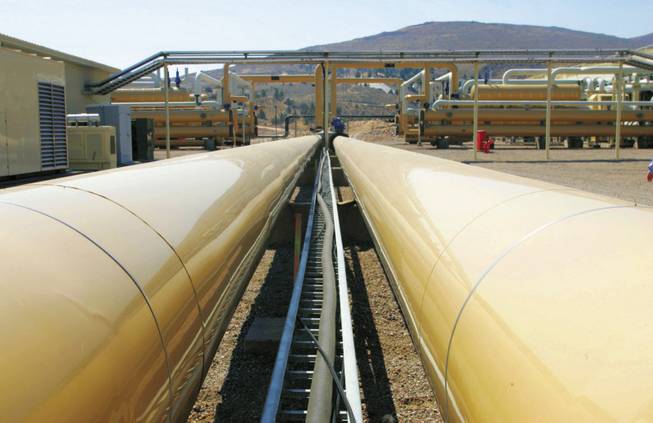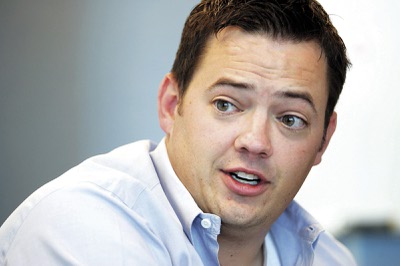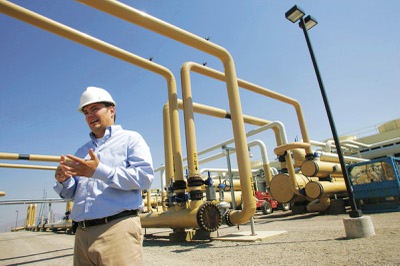
Ormat Technologies, which developed this geothermal plant south of Reno, will team with Nevada Power Co. to build a 30-megawatt plant near Fallon.
Thursday, March 27, 2008 | 2 a.m.
Audio Clip
- Paul Thomsen of Ormat Technologies explains the technology used at the Carson Lake project.
-
Audio Clip
- Thomsen on what the project represents.
-
Audio Clip
- Thomsen describes Ormat Technologies.
-
Sun Archives
- Reid: Renewables shorted by Bush budget (2-06-2008)
- Reid's wily power play (10-06-2007)
The state’s largest utility is set to back its commitment to renewable energy with more spending, this time on geothermal power.
Nevada Power Co. will invest in a 30-megawatt plant near Fallon that will use steam heated by the earth to turn an electricity-producing turbine, the company announced Wednesday. Michael Yackira, president and chief executive of Sierra Pacific Resources, Nevada Power’s parent company, has recently touted a three-pronged plan to meet growing power demand in Nevada: more conservation and renewable energy in addition to controversial coal-fired power plants.
The utility and Ormat Technologies, a geothermal developer, will each own 50 percent of the Carson Lake project, as it is called. Ormat officials said the venture is the first time an investor-owned utility has directly invested in a geothermal project in the United States.
Typically, utilities leave the construction and operation of geothermal and other green projects to specialized renewable energy developers, then purchase the electricity they produce.
Paul Thomsen, public policy manager for Ormat, said the different approach is possible with this geothermal plant because the utility “is so confident the project will be built and produce reliable power for its customers.”
“This represents a big shift in the thinking of utilities, that they’ve realized geothermal is no longer a high-priced alternative, but a competitive ... energy supply that they’re willing to invest in,” Thomsen said.
The plant, to be built on a combination of private and federal lands, is to produce enough power for at least 22,000 homes. Part of the project will be on Naval Air Station Fallon in Churchill County.
Nevada Power must seek approval from the Nevada Public Utilities Commission before it invests in the plant. Ormat has obtained all other permits and leases necessary to begin construction, according to Thomsen.
Neither Yackira nor Thomsen would reveal Wednesday how much the project would cost. That information will be available if the project is approved by the utilities commission.
Yackira said Sierra Pacific Resources had long been in discussions with Ormat about a joint development project. The developer sells geothermal power to Sierra Pacific Resources from its other facilities in the Reno area.
“We’re fortunate in this state to have ... sources of renewable energy in good form and good fashion in abundance,” Yackira said. “Geothermal is an excellent form of energy production ... similar to a traditional power plant in that it (produces power) most of the time.”
Sierra Pacific Resources executives have said the utility can’t rely too heavily on solar and wind power to provide the state with energy because those sources don’t produce when the sun isn’t shining or the wind isn’t blowing. Geothermal energy is considered base-load power, or power that is produced constantly. So are coal-fired power plants such as the one proposed by Sierra Pacific Resources for an area outside Ely in White Pine County.
Thomsen said the costs of geothermal power are competitive with those of traditional power sources such as coal and natural gas.
“We are insulating the utility because they are having trouble saying, ‘What are natural gas prices going to be five years from now?’ ” Thomsen said, adding that the price of electricity from the Carson Lake plant will be constant for decades. “That’s becoming incredibly sexy to these guys, who are dealing with prices jumping all over the place. Predictability and reliability (of price) are becoming a lot more important, and I think we’ll see a lot more geothermal development.”
Although Yackira agreed that energy resources with static fuel costs — such as renewables — do stabilize overall electricity prices, he said the plant will make up a very small portion of the utility’s portfolio. The plant will meet about one-half of 1 percent of the utility’s total demand — 30 megawatts out of 6,000 megawatts needed in Southern Nevada.
The energy from this plant will count toward the state’s requirement that utilities obtain 20 percent of the energy they provide from renewable sources by 2015.
“Every step you can make to try to stabilize price is a good step forward, and this certainly does that,” Yackira said.
Sierra Pacific Resources had announced another renewable energy project this week, also to be constructed by Ormat.
Ormat developed technology — now being used in North and South Dakota, Louisiana and Canada — to produce electricity from what would otherwise be wasted heat.
The project will use waste heat from a natural gas compressor on the Kern River pipeline in Goodsprings, 35 miles south of Las Vegas. The small project, which requires utilities commission approval, will produce enough electricity for about 1,200 homes, according to the utility. The cost of that project was also unavailable.
Although environmentalists applauded the announcements, they said they still oppose the utility’s plans to develop coal-fired power in eastern Nevada.
“If this is part of a comprehensive movement towards clean energy as a wise investment then we salute the efforts of Sierra Pacific and Nevada Power,” said Lydia Ball of the Nevada Clean Energy Campaign, who is also a regional representative of the Sierra Club. “But if this is a minor attempt to add a minimal amount of renewable energy required by the law while still pushing to build a massive amount of dirty polluting energy, then they will hurt not only the company but Nevada ratepayers, too.”



Join the Discussion:
Check this out for a full explanation of our conversion to the LiveFyre commenting system and instructions on how to sign up for an account.
Full comments policy